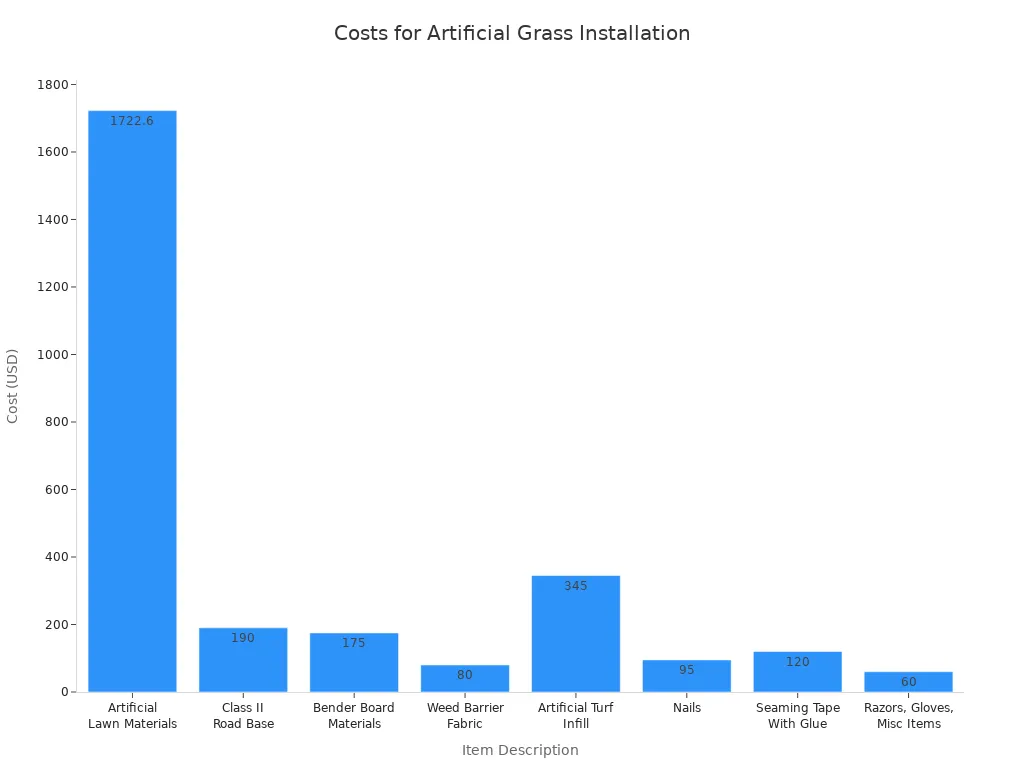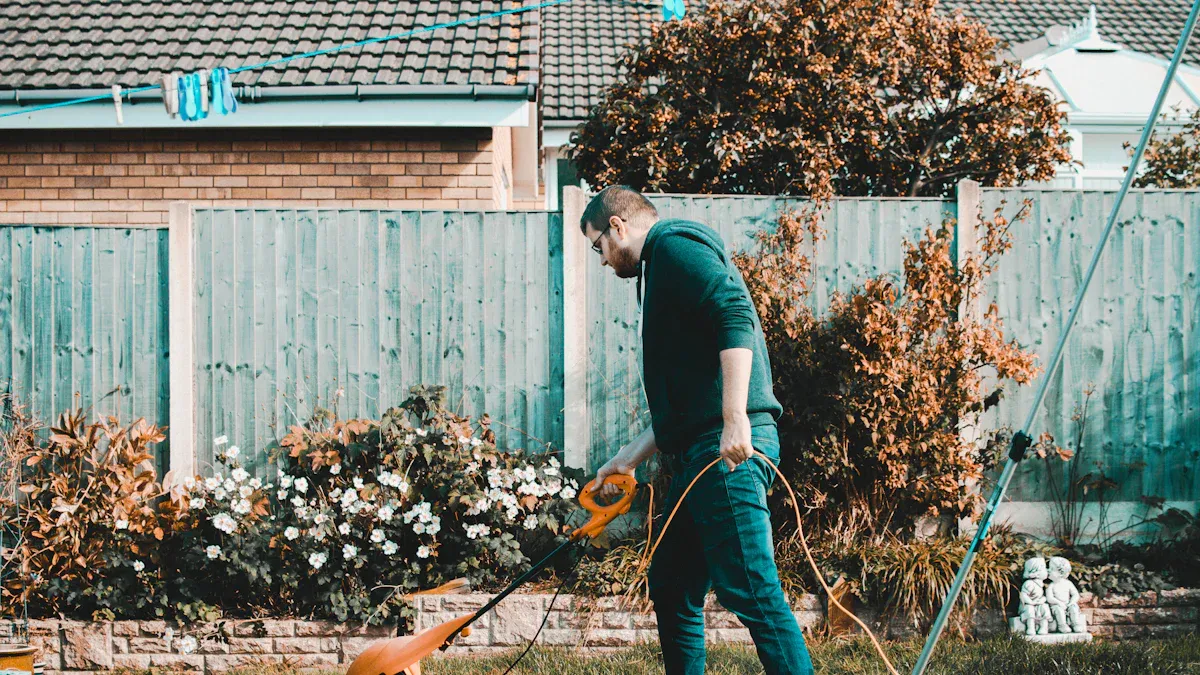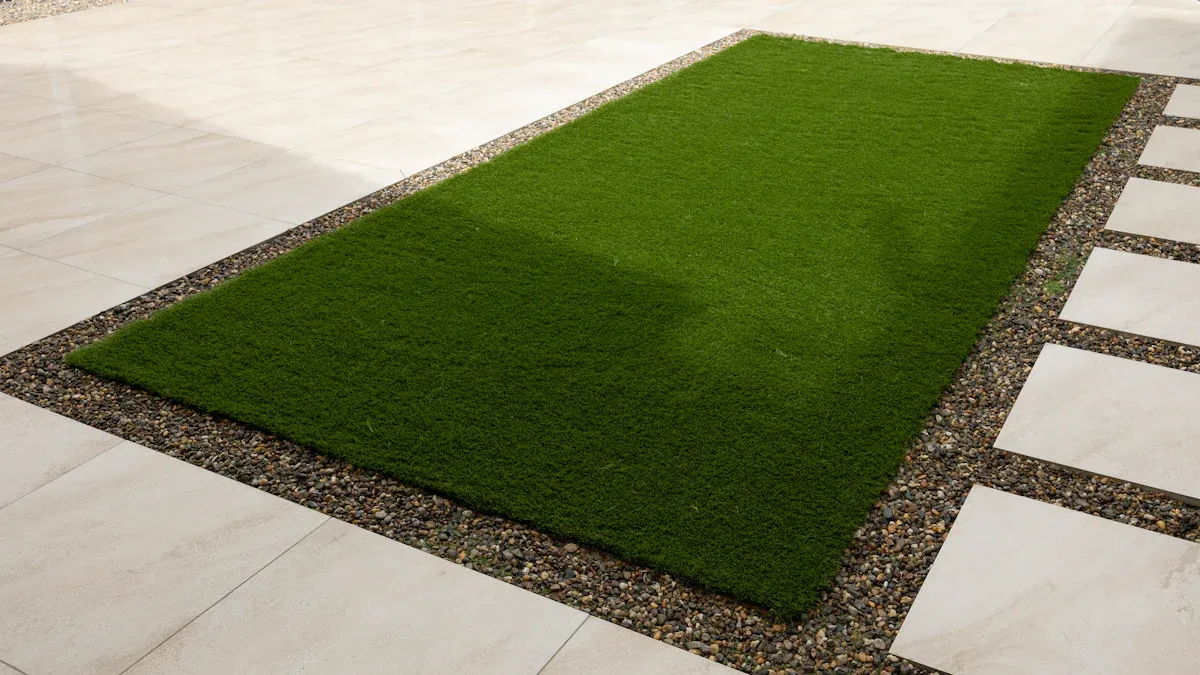Wondering how to put artificial grass in your backyard? You can do this project yourself. You will save money if you do not hire professionals. Many people like to do it themselves. It is easy and feels good to finish. Look at the table below. It shows how artificial grass needs less work and saves water compared to natural grass.
| Feature | Artificial Grass | Natural Grass |
|---|---|---|
| Maintenance | Low maintenance, no mowing or watering needed | Needs mowing and watering often |
| Water Usage | Does not require watering | Needs a lot of water |
You will feel sure as you follow easy steps. You can make your yard look new.
Key Takeaways
- Look at your backyard before you begin. Check if the ground is sloped. See if water drains well. This helps make a strong base for artificial grass.
- It is important to measure carefully. Measure the widest part of your yard. Measure the longest part too. This helps you buy the right amount of materials.
- Pick the best artificial grass for your needs. You can choose pet turf, playground turf, or sports turf. Each type has special features.
- Get the ground ready the right way. Take out old grass first. Put down a weed barrier. Make the base solid and flat. This helps your artificial grass last longer.
- Take care of your turf often. Check it every month. Clean up leaves and trash. Pull out weeds when you see them. This keeps your artificial grass looking nice.
Plan and Measure Your Space
Assess Area
Before you start your artificial grass installation, take a good look at your backyard. Walk around and notice any slopes, tree roots, or odd shapes. These features can affect how you lay your turf grass. You want to make sure water drains well, so check if the ground has a slight slope. This helps guide water away from your house and keeps your fake grass dry. If you see any spots where water pools, plan to fix those.
Tip: A solid base with good drainage keeps your artificial turf looking great for years.
Here are some things to keep in mind:
- Make sure the base is permeable for drainage.
- Think about the tools and materials you will need.
- Test the soil and check for any grading issues.
- Map out any unique challenges like slopes or tree roots.
Measure Dimensions
Grab a tape measure and get ready to measure your space. Even if your yard has curves or angles, measure the widest and longest points as if it were a rectangle. This makes it easier to figure out how much artificial grass you need.
- Measure the widest and longest points of your area.
- Multiply the width by the length to get the total square footage.
- Use this number to estimate how much turf grass and infill to buy.
Accurate measurements help you avoid overspending or ending up with awkward gaps. Double-check your numbers before you order your artificial turf.
Sketch Layout
Now, sketch a simple layout of your backyard on paper. Mark where you want to place the artificial grass and note any tricky spots. This drawing helps you plan the installation and spot any problems before you start.
| Challenge | Description |
|---|---|
| Accurate Measurements | Measure carefully to avoid mistakes and wasted materials. |
| Importance of Planning | Good planning helps you order the right amount of fake grass and supplies. |
| Solid Foundation | A strong base keeps your artificial grass installation looking fresh longer. |
A clear plan and a good sketch make your artificial grass project much smoother. You will feel more confident and ready to move on to the next step.
Gather Materials and Tools
Artificial Grass and Supplies
You want your backyard to look nice and last long. Choosing the right artificial grass and supplies is important. There are different kinds of turf you can buy. Pet turf is good if you have dogs. Playground turf is soft for kids. Sports turf is strong for lots of use. Golf putting greens are smooth for practice.
| Type of Artificial Grass | Key Features |
|---|---|
| Pet Turf | Antimicrobial coating, drains well, tough fibers, mud-free |
| Playground Turf | Shock-absorbing, UV protection, easy to clean |
| Sports Turf | High traction, shock absorption, strong fibers |
| Golf Putting Greens | Short pile, eco-friendly, low maintenance |
You also need things like infill, weed barrier fabric, nails, and seam tape. These help your turf stay in place and look real.
Essential Tools
Having the right tools makes installing artificial grass easier. Here is a list to help you get ready:
- Industrial power broom
- Carpet kicker
- Turf gripper
- Weed & grass killer
- Pet odor eliminator
- Pooper scooper
- Turf rake
- Work gloves
- Knee pads
- Premium turf adhesive
- Commercial grade turf seam tape
- Turf knee kicker
- Turf puller
- Line cutter tool
- Turf edge trimmer
- Heavy duty shears
- Hand push glue spreader
Tip: Gloves and knee pads help you stay safe and comfortable.
Look at the average costs for materials and tools below. This helps you plan how much money you need.
| Item Description | Cost |
|---|---|
| Artificial Lawn Materials (After Taxes) | $1,722.60 |
| Class II Road Base | $190 |
| Bender Board Materials and Stakes | $175 |
| Weed Barrier Fabric | $80 |
| Artificial Turf Infill | $345 |
| Nails | $95 |
| Seaming Tape With Glue for Seams or Staples | $120 |
| Razors, Gloves, and Misc Items | $60 |

Where to Buy
You want good products for your backyard. Many people buy from Artificial Turf Supply. They sell soft turf that lasts in any weather. You can get free quotes and samples from their website. Their turf works for yards, sports fields, and businesses.
| Feature | Details |
|---|---|
| Source | Artificial Turf Supply |
| Product Quality | High-quality, pesticide-free, weather-resistant, soft to the touch |
| Installation Supplies | Offers installation guides and services |
| Free Quote and Samples | Available through their website |
| Applications | Suitable for backyards, sports fields, commercial landscapes, etc. |
This guide helps you choose the best materials and tools for your project. If you pick well, your lawn will look nice and last many years.
Prepare the Ground

Getting the ground ready is a big part of making your artificial grass look great and last a long time. You want a smooth, stable surface that drains well and keeps weeds away. Here’s how you can do it:
Remove Grass and Debris
Start by clearing out all the old grass, weeds, and any debris from your yard. Use a shovel or a sod cutter to dig down about 2 to 3 inches. This step gives you space for the new base. Make sure you remove roots and rocks so nothing pokes through later. After you clear the area, use a plate compactor or hand tamper to press down the soil. This makes the ground firm and helps prevent bumps.
Tip: A solid, compacted surface keeps your artificial grass from shifting or sinking over time.
Lay Weed Barrier
Next, roll out a weed barrier fabric over the entire area. Pick a heavy-duty, non-woven or geotextile fabric. This type lets water drain fast and stands up to pressure. It also resists sunlight, so it won’t break down quickly. Make sure the fabric lays flat and covers every inch. Overlap the edges by a few inches to stop weeds from sneaking through. Investing in a good weed barrier saves you trouble later.
Add and Compact Base
Now, add a layer of crushed stone or decomposed granite. For most backyards, aim for a base that’s 3 to 4 inches thick. Use 3/4-inch minus crushed stone because it packs down tight and drains water well. Spread the base evenly, then use your compactor again. Check for level spots and fill in any low areas. A well-compacted base gives your artificial grass a strong foundation and helps water flow away.
Note: The right base keeps your lawn looking fresh and feeling soft underfoot.
By following these steps, you set yourself up for a smooth artificial grass installation. Your yard will look neat, drain well, and stay weed-free for years.
Install Artificial Grass

You’re almost done! Now comes the fun part—laying down your artificial grass and making your backyard look amazing. Let’s break it down step by step so you can get a smooth, natural finish.
Roll Out and Cut Turf
Start by unrolling your artificial grass over the prepared base. Let it sit for about 30 minutes. This helps the turf relax and smooths out any creases from being rolled up. You want your fake grass to look flat and even.
Here’s a simple way to get the perfect fit:
- Unroll the turf and let it settle.
- Use a sharp utility knife for straight cuts. Heavy-duty scissors work well for curves and corners.
- Mark your cut lines with chalk or a marker before you start cutting.
- For tricky shapes, make small cuts and trim slowly. This helps you avoid mistakes.
- Lay each piece of turf grass next to the other. Make sure the seams line up and the grain runs in the same direction. This keeps your artificial turf looking real.
Tip: Always check the direction of the grass blades. If you mix up the grain, your lawn might look patchy or fake.
Secure Edges and Seams
You want your artificial grass to stay put, even when kids or pets run across it. Securing the edges and seams is key.
Follow these steps for a strong hold:
- Use non-galvanized 40-D 5-inch turf nails along the edges. Space them every few inches for best results.
- Place seam tape under the seams where two pieces meet. Apply turf adhesive to the tape.
- Lay the turf pieces carefully on top of the tape. Press down so the glue sticks.
- Make sure the pile direction matches across all pieces. This keeps your artificial turf looking seamless.
- Avoid making seams at sharp angles. Try to place seams in low-traffic areas so they stay hidden.
- Weigh down the seams with bags of infill for 24 hours. This helps the glue set and keeps everything in place.
Note: If you skip these steps, your turf grass might shift or lift at the edges. That can cause tripping hazards and make your artificial grass installation look messy.
Add Infill and Brush Fibers
Adding infill is the secret to a soft, natural feel. Infill helps the blades stand up and improves drainage. You have a few choices:
- Silica Sand: Great for drainage and durability. Works well in busy areas.
- Acrylic Sand: Offers UV protection and stays cool in the sun.
- Zeofill: Controls odors and fights bacteria. Perfect for pet-friendly yards.
- Walnut Shell: Biodegradable and absorbs shock. Good for play areas.
- Antibacterial Coated Sand: Stops germs and smells. Ideal for homes with pets.
- Crumb Rubber: Adds cushion and feels like real grass.
Spread the infill evenly across your artificial grass. Use a drop spreader or your hands. Brush the turf with a synthetic bristle brush. Brush against the grain to help the fibers stand up. This makes your fake grass look fuller and more natural.
Pro Tip: Brush your turf grass often, especially in busy spots. Regular brushing keeps the blades upright and clears away dust and dirt.
Here’s a quick table to help you pick the right infill:
| Infill Type | Best For | Special Benefit |
|---|---|---|
| Silica Sand | High traffic | Drainage & durability |
| Zeofill | Pet areas | Odor control |
| Acrylic Sand | Sunny yards | UV protection |
| Walnut Shell | Playgrounds | Shock absorption |
| Antibacterial Coated Sand | Pet-friendly homes | Germ & odor control |
| Crumb Rubber | Sports areas | Cushioning |
After you finish, inspect your artificial grass installation. Look for uneven spots or low infill. Add more if needed. If the blades look flat, brush them again. You want your turf grass to look fresh and feel soft underfoot.
Safety Reminder: Wear gloves and knee pads while working. Follow local rules for turf and infill. Make sure your artificial grass meets safety standards for kids and pets.
You did it! Your backyard now has a beautiful, low-maintenance lawn. Enjoy your new space and remember to brush and check your artificial grass regularly.
Maintenance Tips
Inspect Regularly
You want your artificial grass to look fresh year after year. Regular inspections help you catch problems early. Once a month, walk across your turf grass and check for signs of wear, seam separation, or damage. Look for low spots, loose edges, or areas where the infill looks thin. If you spot any tears or uneven seams, fix them right away. This simple habit keeps your artificial turf safe and looking great.
Tip: Periodic inspections prevent small issues from turning into big repairs. You protect your investment and enjoy your fake grass longer.
| Maintenance Task | Description |
|---|---|
| Regular Inspection | Check for tears, damage, and infill levels |
| Drainage Check | Make sure water flows away and doesn’t pool |
| Pet Waste Management | Remove pet waste quickly to prevent odors and staining |
Clean and Brush
Cleaning your artificial grass is easy. Sweep away leaves, twigs, and dirt every week. Use a stiff brush or a power broom to lift the turf fibers and keep them upright. If you have pets, remove waste as soon as possible. For stains, use mild dish soap and water. Vinegar solutions work well for pet urine and mold. Baking soda helps with odors. For sticky messes, try isopropyl alcohol or a plastic scraper.
- Sweep regularly to remove debris.
- Hose down liquid stains right away.
- Brush the turf grass against the grain to prevent matting.
- Dab stains with a cloth instead of rubbing.
| Cleaning Solution | Use Case |
|---|---|
| Mild dish soap and water | Everyday stains like food spills |
| Vinegar solutions | Pet urine and mold |
| Baking soda | Odor control |
| Enzyme cleaners | Pet stains |
Prevent Weeds
Weeds can sneak into your artificial grass installation if you don’t stay alert. Start by keeping the area clear of debris and fallen leaves. Brush your fake grass often to remove airborne seeds. Make sure the weed barrier fabric under your turf grass stays intact. If you see any weeds poking through, pull them out right away. You can also use a weed killer for stubborn spots.
- Clear the area of debris and existing weeds.
- Use a weed barrier fabric beneath the artificial turf.
- Brush the turf grass regularly to remove seeds.
- Maintain the infill and drainage layer to block weed growth.
Note: Good maintenance helps your artificial grass last between 15 and 25 years. You get a beautiful, low-maintenance lawn that stays green season after season.
You can put artificial grass in your backyard by doing these steps: First, get your area ready and collect your materials. Next, dig out the ground and mark the edges. Then, put down weedblock fabric and add the base layer. After that, press down the base and measure for turf grass. Lay out your artificial turf, cut it to fit, and make sure it stays in place. Add infill to finish your artificial grass installation.
Most people finish DIY fake grass projects in one day. You only need some patience and simple tools. If you want help, you can look at these professional services:
| Service Type | Resource Link |
|---|---|
| Residential Artificial Turf | Residential Installation |
| Pet Turf Grass | Pet Turf Installation |
| Playground Artificial Grass | Playground Turf |
Enjoy your new lawn! Keep your artificial turf clean and check it often. You will like how your backyard looks and feels for many years.
FAQ
How long does artificial grass last in a backyard?
You can expect artificial grass to last 15 to 25 years. Good care and regular cleaning help your turf grass stay green and soft. High-quality fake grass resists fading and wear, even with pets or kids.
Can I install artificial turf myself, or do I need a professional?
You can handle artificial grass installation yourself. Most homeowners finish the project in a day. If you want perfect seams or have a large area, you might hire a pro. DIY saves money and feels rewarding.
Does fake grass get hot in the sun?
Artificial turf can get warm on hot days. You can choose turf grass with cooling technology or add infill that keeps the surface cooler. Shade and water help lower the temperature if it feels too hot.
Will weeds grow through my artificial grass?
Weeds rarely grow through artificial grass if you use a strong weed barrier. Brush your turf grass often and keep the area clean. If you spot weeds, pull them out quickly to keep your lawn looking neat.
How do I clean pet waste from artificial turf?
Pick up solid waste right away. Hose down the area and use mild soap for stains. Enzyme cleaners help with odors. Regular cleaning keeps your artificial grass fresh and safe for pets.






